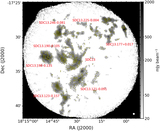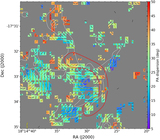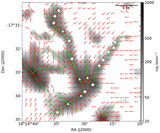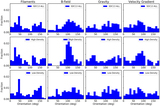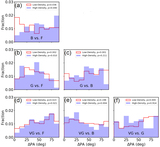Image Details

Caption: Figure 15.
Cartoon figure summarizing the various observed features (Section 5.3). The left panel illustrates the 10 pc scale environment around SDC13 (Section 5.1). The right panel is zooming in to SDC13 (in red; Section 5.2). Black arrows represent the directions of local gravity. Orange curves visualize the magnetic field morphology. The magenta arrows are the directions of gas motions. The light and darker blue background colors display the different local densities. At the 10 pc scale (left panel), a large-scale filament, formed by the collision of large-scale flows with nonzero angular momentum, twists the magnetic field resulting in a large-scale toroidal magnetic field. This toroidal magnetic field guides the ambient denser clouds (dark blue) on their way of being accreted onto the filament. At the parsec scale (right panel), these clouds flow along magnetic field lines and collide at a main convergent point to form a compact hub-filament system with filaments either parallel to the large-scale flow or parallel to the colliding front. At the same time, the small-scale local magnetic field within the shock-compressed layers is enhanced and becomes parallel to the shock-compressed layers and perpendicular to the large-scale magnetic field. After the compact hub-filament system has gained sufficient mass, local gravity starts to dominate over the gas kinematics, leading to gas accretion both toward the filament ridges and the central hub. As the filaments become mostly supercritical and also the central hub reaches a mass-to-flux ratio larget than 1 in local dense regions, the formation of protostellar and starless cores (yellow regions) is enabled.
Copyright and Terms & Conditions
© 2022. The Author(s). Published by the American Astronomical Society.


